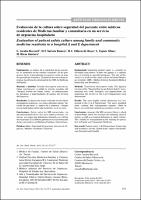Por favor, use este identificador para citar o enlazar este ítem:
https://repositorio.usj.es/handle/123456789/411
Registro completo de metadatos
| Campo DC | Valor | Lengua/Idioma |
|---|---|---|
| dc.contributor.author | Jaraba Becerril, Carlos | - |
| dc.contributor.author | Sartolo-Romeo, M. T. | - |
| dc.contributor.author | Villaverde-Royo, María Victoria | - |
| dc.contributor.author | Espuis Albas, L. | - |
| dc.contributor.author | Rivas Jiménez, Miguel | - |
| dc.date.accessioned | 2020-10-14T08:26:57Z | - |
| dc.date.available | 2020-10-14T08:26:57Z | - |
| dc.date.issued | 2013 | - |
| dc.identifier.citation | JARABA BECERRIL, C. et al. Evaluación de la cultura sobre seguridad del paciente entre médicos residentes de Medicina familiar y comunitaria en un servicio de urgencias hospitalario. Anales Sis San Navarra [online]. 2013, vol.36, n.3, pp.471-477. ISSN 1137-6627. http://dx.doi.org/10.4321/S1137-66272013000300012. | es_ES |
| dc.identifier.issn | 1137-6627 | es_ES |
| dc.identifier.uri | https://repositorio.usj.es/handle/123456789/411 | - |
| dc.description | Background. Improving patient safety is a priority in all health care centres. It does not appear as a specific area of training in specialty programs. The aim of this study is to evaluate the safety culture of Family Medici-ne residents (MIR - Médico Interno Residente/Medical Internship and Residency).Methods. Transversal descriptive study. The Spanish version of the "Hospital Survey on Patient Safety" ques-tionnaire was used. Strengths and opportunities for improving the service of the A & E Department were determined.results. The most highly valued dimension was tea-mwork in the A & E Department. The worst qualified were "staffing" and "management support". None of those surveyed had notified any incidents in the unit.conclusions. Amongst the MIR surveyed there is a lack of knowledge about the channels for notifying adverse events, as well as a training deficiency in safety culture. This should be strengthened in the training of specia-lists in Family and Community Medicine. | es_ES |
| dc.description.abstract | Fundamento. La mejora de la seguridad de los pacien-tes es prioritaria en los centros sanitarios. En los pro-gramas de las especialidades no aparece como un área de aprendizaje específica. El objetivo de este trabajo es evaluar la cultura de seguridad de los MIR de Medicina de Familia.Material y métodos. Estudio descriptivo transversal. Como cuestionario se utilizó la versión española del "Hospital Survey on Patient Safety". Se determinaron las fortalezas y oportunidades de mejora del servicio de Urgencias.resultados. La dimensión mejor valorada fue el trabajo en equipo en urgencias. Las peor calificadas fueron "do-tación de personal" y "apoyo de la gerencia". Ningún encuestado había notificado incidentes en el servicio.conclusiones. Existe, entre los MIR encuestados, un desconocimiento de las vías para notificar eventos ad-versos, así como una deficiencia formativa en cultura de seguridad. Ésta debería potenciarse en la formación de los especialistas en Medicina Familiar y Comunitaria | es_ES |
| dc.format.mimetype | application/pdf | es_ES |
| dc.language.iso | spa | es_ES |
| dc.publisher | Gobierno de Navarra | es_ES |
| dc.rights | Atribución-NoComercial 4.0 Internacional | * |
| dc.rights.uri | http://creativecommons.org/licenses/by-nc/4.0/ | * |
| dc.subject | Seguridad del paciente | es_ES |
| dc.subject | Servicio de Urgencias | es_ES |
| dc.subject | Médicos residentes | es_ES |
| dc.subject | Encuesta | es_ES |
| dc.title | Evaluación de la cultura sobre seguridad del paciente entre médicos residentes de Medicina familiar y comunitaria en un servicio de urgencias hospitalario | es_ES |
| dc.title.alternative | Evaluation of patient safety culture among family and community medicine residents in a hospital A and E department | es_ES |
| dc.type | journal article | es_ES |
| dc.subject.unesco | Medicina clínica | es_ES |
| dc.identifier.publicationfirstpage | 471 | es_ES |
| dc.identifier.publicationlastpage | 477 | es_ES |
| dc.identifier.doi | http://dx.doi.org/10.4321/S1137-66272013000300012. | es_ES |
| dc.rights.accessRights | open access | es_ES |
| Aparece en las colecciones: | Artículos de revistas | |
Ficheros en este ítem:
| Fichero | Descripción | Tamaño | Formato | |
|---|---|---|---|---|
| evaluación de la cultura sobre seguridad del paciente entre médicos residentes de Medicina familiar y comunitaria en un servicio de urgencias hospitalario.pdf | 131,45 kB | Adobe PDF |  Visualizar/Abrir |
Este ítem está sujeto a una licencia Creative Commons Licencia Creative Commons

